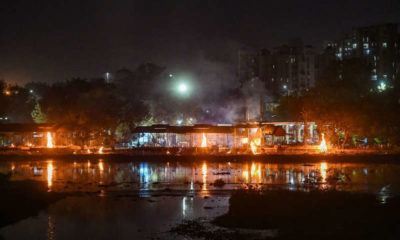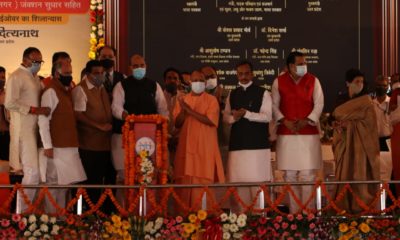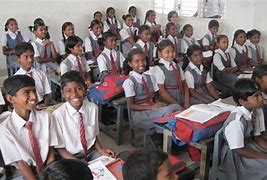Feature
‘Central files on Netaji may not unravel his disappearance’

Kolkata: The Centre’s act of declassifying secret files on Netaji Subhas Chandra Bose may not help in unravelling the mystery surrounding his disappearance, noted journalist and author Kingshuk Nag has said.
“Prime Minister Narendra Modi has just promised, he is yet to act on that. Even if all the central government files are declassified, I am not sure, if they will have all the answers that people are seeking to know about Netaji,” Nag told during the launch of his book ‘Netaji: Living Dangerously’ on Tuesday.
“I doubt if the files will have all the information, because some of the important files may be missing, may be doctored long before Modi became the prime minister,” said the Prem Bhatia Memorial Award winner.
Following a meeting with a host of Netaji descendants and historians, Modi in October announced the Centre will declassify files related to Bose from January 23 – his birth anniversary.
The prime minister also assured he would request foreign governments, including Russia, to declassify files related to Netaji available with them.
Nag, who in his book has dealt about the various theories surrounding Netaji’s disappearance following an alleged air crash in Formosa (now Taiwan) on August 18, 1945, claims the answer to Bose’s disappearance lie hidden in secret files with the Russian, British and the Japanese governments.
“The Indian government files may mostly carry certain passing references about Netaji. The real mystery behind his disappearance may be revealed only if the files with the Russian, British and Japanese governments are declassified,” Nag said.
Eminent historian Hari Vasudevan opined the Modi government ought to have sought the services of experts for the process of declassification of over 120 files said to be with the various central departments, including the prime minister’s office.
“We don’t know what files will be classified so it is difficult to say whether they will be able to answer the questions that we all have been seeking.
“But, I don’t think it is adequate that files are just randomly declassified without allowing experts, or historians to ask questions,” Vasudevan told.
“It’s essential that people who are interested in the matter, people who have expertise are involved, so that they may pose questions and seek answers to judge the relevance of a document being declassified,” added the specialist in Russian and European history at Calcutta University.
Netaji’s niece Chitra Ghosh, however, exuded confidence that the files would bring out much-needed answers to the one of the most intriguing mysteries in the country.
Trinamool Congress leader Derek O’Brien, who unveiled the book, compared it with Meghna Gulzar-directed movie “Talvar” which uses the ‘Rashomon effect’ to deal with the various theories surrounding the sensational Aarushi Talwar double murder case.
“Much like the movie “Talwar” which deals with multiple theories about an incident, Kingshuk’s book too deals with different theories with the author smartly pushing in his own theories which he thinks are probable.”
O’Brien also welcomed the Centre’s declassification move.
“Mamata Banerjee took a historic decision by declassifying the files and after that the Centre followed suit. It is a good step, we want the truth, the country must know what really happened to Netaji,” he said.
Giving a riveting account in his bid to answer the various questions surrounding the disappearance of Netaji, Nag in his book has rejected the Taiwan plane crash theory and pointed to the possibility that ‘Gumnami Baba’, an ascetic living in Uttar Pradesh’s Faizabad, was Bose in disguise.
Entertainment
Meghalaya Reserves Legalized Gambling and Sports Betting for Tourists

The State Scores Extra High on Gaming-Friendly Industry Index
Meghalaya scored 92.85 out of 100 possible points in a Gaming Industry Index and proved to be India’s most gaming-friendly state following its recent profound legislation changes over the field allowing land-based and online gaming, including games of chance, under a licensing regime.
The index by the UK India Business Council (UKIBC) uses a scale of 0 to 100 to measure the level of legalisation on gambling and betting achieved by a state based on the scores over a set of seven different games – lottery, horse racing, betting on sports, poker, rummy, casino and fantasy sports
Starting from February last year, Meghalaya became the third state in India’s northeast to legalise gambling and betting after Sikkim and Nagaland. After consultations with the UKIBC, the state proceeded with the adoption of the Meghalaya Regulation of Gaming Act, 2021 and the nullification of the Meghalaya Prevention of Gambling Act, 1970. Subsequently in December, the Meghalaya Regulation of Gaming Rules, 2021 were notified and came into force.
All for the Tourists
The move to legalise and license various forms of offline and online betting and gambling in Meghalaya is aimed at boosting tourism and creating jobs, and altogether raising taxation revenues for the northeastern state. At the same time, the opportunities to bet and gamble legally will be reserved only for tourists and visitors.
“We came out with a Gaming Act and subsequently framed the Regulation of Gaming Rules, 2021. The government will accordingly issue licenses to operate games of skill and chance, both online and offline,” said James P. K. Sangma, Meghalaya State Law and Taxation Minister speaking in the capital city of Shillong. “But the legalized gambling and gaming will only be for tourists and not residents of Meghalaya,” he continued.
To be allowed to play, tourists and people visiting the state for work or business purposes will have to prove their non-resident status by presenting appropriate documents, in a process similar to a bank KYC (Know Your Customer) procedure.
Meghalaya Reaches Out to a Vast Market
With 140 millions of people in India estimated to bet regularly on sports, and a total of 370 million desi bettors around prominent sporting events, as per data from one of the latest reports by Esse N Videri, Meghalaya is set to reach out and take a piece of a vast market.
Estimates on the financial value of India’s sports betting market, combined across all types of offline channels and online sports and cricket predictions and betting platforms, speak about amounts between $130 and $150 billion (roughly between ₹9.7 and ₹11.5 lakh crore).
Andhra Pradesh, Telangana and Delhi are shown to deliver the highest number of bettors and Meghalaya can count on substantial tourists flow from their betting circles. The sports betting communities of Karnataka, Maharashtra, Uttar Pradesh and Haryana are also not to be underestimated.
Among the sports, cricket is most popular, registering 68 percent of the total bet count analyzed by Esse N Videri. Football takes second position with 11 percent of the bets, followed by betting on FIFA at 7 percent and on eCricket at 5 percent. The last position in the Top 5 of popular sports for betting in India is taken by tennis with 3 percent of the bet count.
Local Citizens will Still have Their Teer Betting
Meghalaya residents will still be permitted to participate in teer betting over arrow-shooting results. Teer is a traditional method of gambling, somewhat similar to a lottery draw, and held under the rules of the Meghalaya Regulation of the Game of Arrow Shooting and the Sale of Teer Tickets Act, 2018.
Teer includes bettors wagering on the number of arrows that reach the target which is placed about 50 meters away from a team of 20 archers positioned in a semicircle.
The archers shoot volleys of arrows at the target for ten minutes, and players place their bets choosing a number between 0 and 99 trying to guess the last two digits of the number of arrows that successfully pierce the target.
If, for example, the number of hits is 256, anyone who has bet on 56 wins an amount eight times bigger than their wager.























